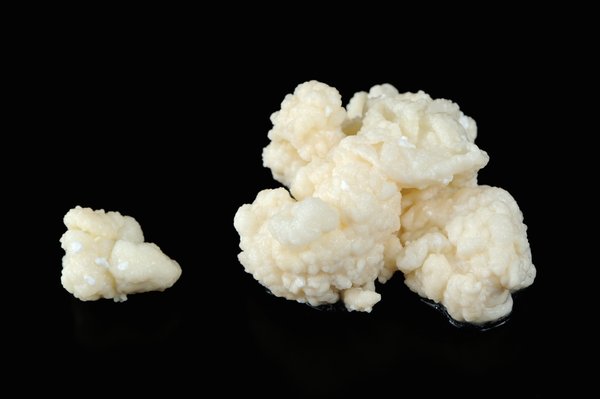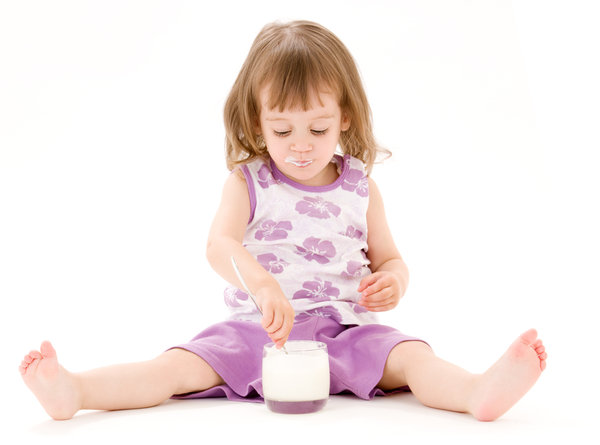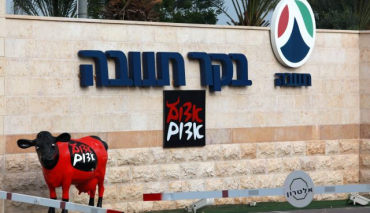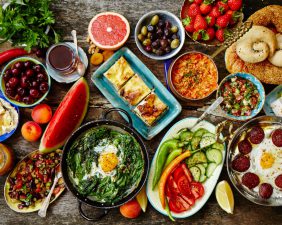Nomads of the Caucasus Mountains attribute their long, vigorous lives to a natural diet, plenty of outdoor exercise – and kefir. Kefir is fermented milk, something like yogurt. Its taste ranges from mildly sour to cheeselike, depending on how long the milk ferments. It has lots of probiotics and proven anti-bacterial power.
As Kombucha tea does, kefir helps the body to metabolize foods, and also raises immunities. Studies show that drinking kefir every day regulates blood pressure and blood sugar levels.
And like Kombucha, the origins of the “mother” substance are lost in ancient history. Legend has it that Mohammed himself gifted the nomad community with the yellowish-white kefir culture “grains,” and taught them how to ferment milk with them. We posted about black cumin, another legendary gift from Mohammed, here.
Science says, according to Wikipedia, that kefir is a combination of ” lactic acid bacteria and yeasts in a matrix of proteins, lipids, and sugars, and this symbiotic matrix, or (SCOBY) forms “grains” that resemble cauliflower. For this reason, a complex and highly variable community of lactic acid bacteria and yeasts can be found in these grains.”
The nomads jealously guarded kefir’s secret for centuries, but eventually the fame of the magic milk reached Russian society.
Small quantities of kefir became available, made cottage-industry fashion in a few people’s homes. Doctors prescribed it for digestive troubles and tuberculosis. In the late 19th century, Moscow physicians published studies attesting to kefir’s medicinal properties. Convinced, the All Russian Physician’s Society determined to produce kefir on a large scale.
But “mother” grains were scarce, and the people of the Caucasus wouldn’t yield the secret.
In 1908, the Physician’s Society approached the Blandov brothers, owners of a big Moscow dairy, and asked for help in obtaining kefir grains. The Blandovs agreed to send an emissary to the Caucasus, on condition of receiving exclusive rights to manufacturing kefir. The agent was an employee of their dairy, a beautiful young woman named Irina Sakharov.
Irina traveled north and met with the ruling prince of the region. He wouldn’t give her kefir grains. Instead, he kidnapped her on her return journey home, and demanded that she marry him. But all ended well for Irina, for the men who had accompanied her from Moscow rescued her and brought the case before the prince’s father.
To avert conflict with the powers in Moscow, the king granted Irina enough grains to start large-scale manufacture of kefir. Some say it was a cup of grains, some say it was a sheepskin-full. What’s known is that the grains Irina brought home from her adventures are the mothers of just about all the kefir that’s drunk in Russia, Eastern and Western Europe, Australia and the USA today.
 In 1973, Irina received official recognition and thanks for having brought kefir to Russia.
In 1973, Irina received official recognition and thanks for having brought kefir to Russia.
Today, commercial kefir drinks are even sold in supermarkets. But you won’t know if you’re getting just a pleasantly yogurt-like drink without real health benefits. It’s worth fermenting your own kefir at home. And it’s ridiculously easy.
In spite of the huge mystique made around kefir, all you have to do is place a mother grain or two in the bottom of a clean glass jar and fill the jar with milk. Stir gently, with a wooden or plastic spoon, and cover with a clean kitchen towel. Leave out overnight.
By morning, you’ll have thick, white kefir. It may have a little fizz, which is fine.
Pour off a glass and enjoy, or make a smoothie from it. Just don’t drink down the mother, or you’ll have to get another one! The longer you leave the milk to ferment, the thicker and more sour the kefir. The mother grains will continue growing if left in milk.
Eventually “baby” buds will break off that will continuing growing and become mothers in turn. You may find your jar crowded with grains after a while.Then you might want to distribute some among your friends. Or you may join the international kefir lovers who mail out grains, enclosed with a little milk in zip-locked bags, only for the price of shipping.
I wrote about kefir in my own blog, several years ago, and ever since then, have had to fend off strangers asking me for grains. I usually reply, grumpily, that I had bought my original mother via eBay for about $4 and that they can do the same.
My own kefir grains don’t reproduce much. They make one or two new mothers over a year’s time. I don’t know why. Apparently kefir grains respond individually to their particular environment: the type of milk used, and how or where they’re stored. In someone elses’ kitchen, maybe they would make many more babies. But I’m fine with what I have. I don’t like being regarded as a source for kefir grains.
This week, a different sort of request for kefir grains appeared in my Inbox. It’s for a little girl, I read.
Something in me gave way. Alright, for a child, I’ll go through the bother of receiving a stranger into my home, explaining about kefir and how to store it in between fermentations (covered with fresh milk, in the refrigerator), and how it has to be kept cool. Kefir has its conditions for optimal life, just like any other fresh, living thing. I sighed.
Okay, I wrote back, Come over.
The little girl’s mother knocked on my door that evening. “Why does your daughter need kefir?” I asked, showing her in.
The lady turned haunted eyes to me. “Her name is Noa. She’s only a year and four months old. She has cancer. They’ve already removed her ovaries. We’re hoping to avoid chemotherapy and manage it with surgery. But she needs everything she can get to stay strong.”
I swallowed, and tears came to my eyes. An innocent little girl, with such a terrible thing. God willing, she’ll survive, but she’ll never bear children.
And I was humbled. You just never know what might come of things you do, say, or write. Maybe my post, written four years before Noa was even born, came out of my computer for no other reason than to help her in the end.
I explained the health benefits of kefir and advised how to feed Noa with it. I told her mother that while my mothers never reproduce much, hers may very well make lots of baby grains. Her face brightened.
“If I see that it really helps, and it makes more mothers, I’ll give kefir grains out to everyone in the oncology ward,” she exclaimed. “I’ll get so many mitzvas that way!”
I hope so. I hope that many little zip-locked bags containing new kefir grains will go out of Noa’s house to help other sick children. May Noa bat Revital will have a complete healing of body and spirit. May she go on to a good life.
There’s lots of online information about kefir. Just google it and you’ll get full instructions on here to obtain grains, how to make it, and recipe.
More alternative health practices on Green Prophet:
Images of a little girl with kefir, and kefir “mother” grains via Shutterstock





2 thoughts on “Kefir, legendary health milk traced back to Mohammad’s gift”
Comments are closed.